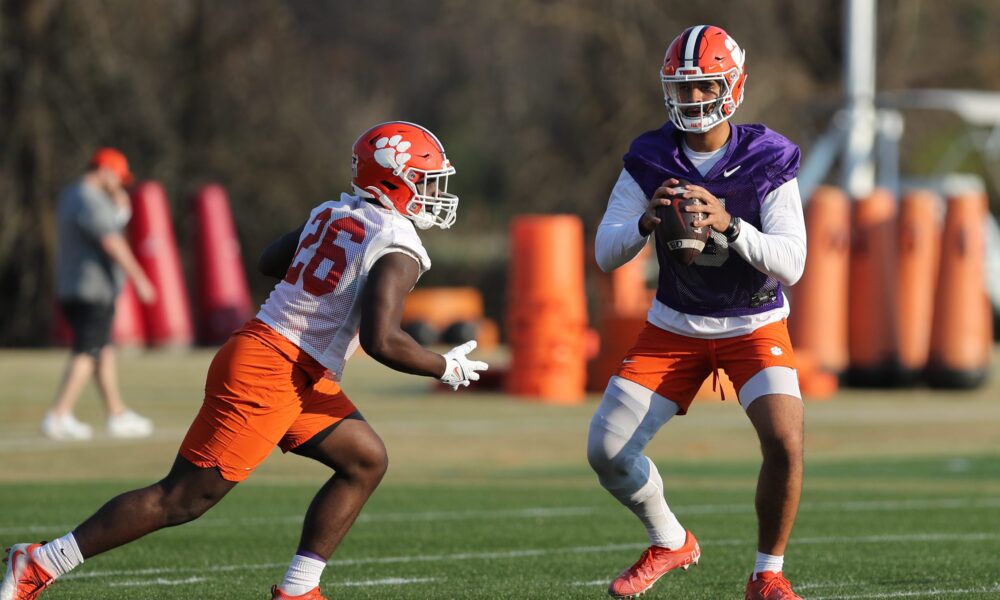Clemson Variety & Frame is doing their part to help bring you some classic new barware and help one of the local businesses that helps make Clemson special.
Order your Nick’s barware and do your part to help. #SaveNicks

 What emphasizing tempo looks like for Clemson’s offense this spring
What emphasizing tempo looks like for Clemson’s offense this spring
Brandon Streeter is timing Clemson’s offense this spring.
“One thing we’re doing is putting a play clock out on the practice field,” Streeter said. “Just kind of recording how fast we can snap the ball.”
Tempo has been one of the focal points for the Tigers’ first-year offensive coordinator as he works to add his own flavor to a system that’s being tweaked rather than overhauled. The offense took a step back last season in D.J. Uiagalelei’s first season as the full-time starting quarterback, but Tony Elliott’s offense was a largely productive unit the last seven seasons, ranking in the top 15 nationally in total yards five times and top 35 in points in six of those seasons.
Elliott is now at Virginia as a first-time head coach, but tempo isn’t exactly new to the Tigers’ offense. According to teamrankings.com, Clemson ranked in the top 57 nationally in plays per game in each of the first six seasons of Elliott being the primary play caller before averaging just 70.3 plays this past season, the fewest of Elliott’s tenure.
The Tigers dedicated practice periods to repping tempo under Elliott just like they have this spring, but Clemson coach Dabo Swinney said that doesn’t mean the Tigers are constantly looking to operate at warp speed.
“We really wanted to put a big emphasis on tempo and really be able to play and control the tempo like we want,” Swinney said. “It’s not just going fast. It’s being able to vary the tempo and understanding when and where and how to do that through our cadence, through just how we get the plays in, everything. So we’ve changed a few things up, but the tempo has been really good.”
Streeter acknowledged the primary focus of incorporating tempo within the offense this spring has been getting players lined up on the ball as quickly as possible after the conclusion of the previous play and going from there.
“If we can get lined up, that’s going to force the defense to get lined up,” Streeter said. “Then we can dictate whether we want to snap it fast or we want to be able to hold their water a little bit, get into a great play and make it a downhill play for us. So we have definitely stressed that.”
Ideally, how quickly does Streeter want the ball snapped on the next play? He said that depends how quickly he can get the call in, but the defense — and how the offense decides to combat its looks from play to play — will factor in as well.
“It starts with me, but we want to get them lined up between 30-35 seconds on the (play) clock and try to snap it above 20,” he said. “Try to. It’s not going to always be that case because we may have a cadence where we want to really catch the defense off guard and might have some checks that our quarterback has to handle that the play clock is going to get under 20, and that’s fine. Certain situations maybe on third down or whatever. We’ve got to get in a good play, but I do want the presnap intensity to get lined up and then be able to execute at a little bit better tempo.”
Practicing with a sense of urgency, Streeter believes, will pay dividends come game day.
“I really believe with the tempo, you can create rhythm,” Streeter said. “And I think that’s so important with an offense is creating rhythm. That way, they’re so used to going fast that usually in the game it slows down for them and allows them to play fast.”
Clemson Variety & Frame is doing their part to help bring you some classic new barware and help one of the local businesses that helps make Clemson special.
Order your Nick’s barware and do your part to help. #SaveNicks
